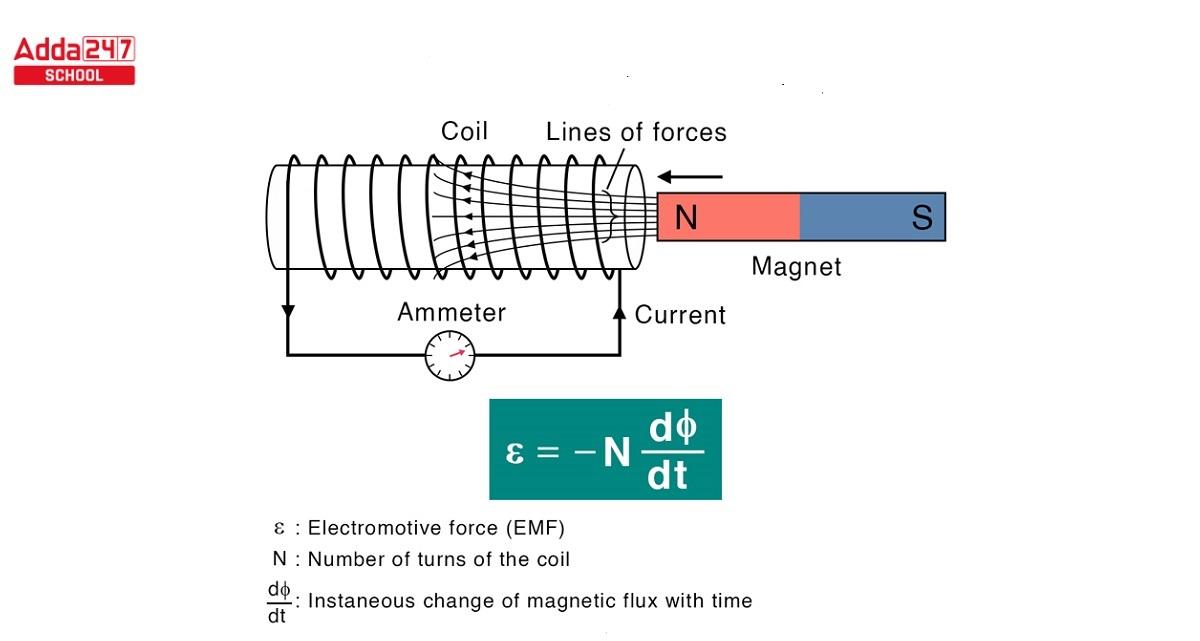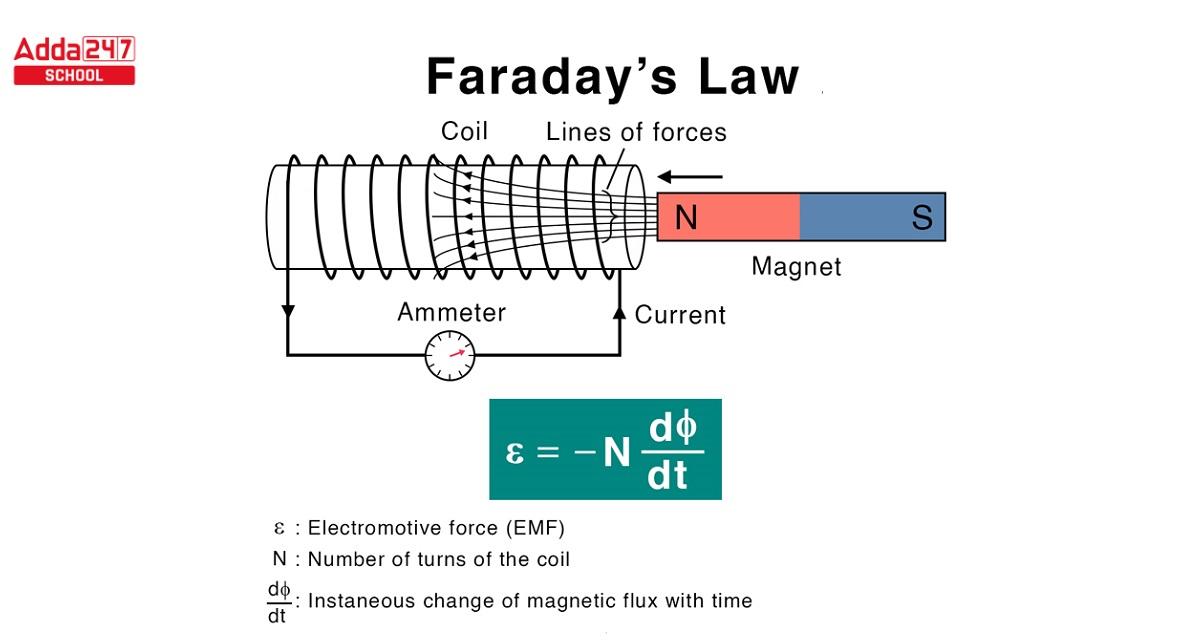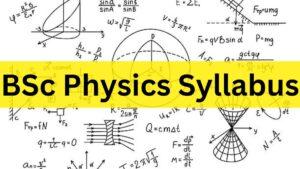Faraday’s law: Faraday’s law of electromagnetic induction, commonly known as Faraday’s law, is a fundamental law of electromagnetism that explains how a magnetic field interacts with an electric circuit to produce an electromotive force (EMF). This is referred to as electromagnetic induction. In 1831, Michael Faraday proposed the rules of electromagnetic induction. Faraday’s law, also known as the law of electromagnetic induction, is the consequence of Faraday’s experiments. To uncover the phenomenon of electromagnetic induction, he conducted three major experiments.
Faraday’s Law of Induction Class 12 and 10 Definition
Faraday’s law of induction is an electromagnetic law that outlines how a changing magnetic field can cause an electromotive force (EMF) to be generated in a conductor. Michael Faraday proposed the law for the first time in 1831.
According to Faraday’s law of induction, the amplitude of an induced EMF in a conductor is directly proportional to the rate of change of the magnetic flux through the conductor.
Faraday’s Law of Induction Class 12, 10
Faraday’s Laws of Electromagnetic Induction are separated into two parts. The first law specifies emf induction in a conductor, while the second law quantifies emf generated in the conductor. In the next sections, we will go over these laws in further detail.
Faraday’s First Law of Electromagnetic Induction
According to the first law of electromagnetic induction, whenever the magnetic flux associated with a coil changes, EMF is induced in that coil. The number of magnetic field lines that travel through a surface is referred to as magnetic flux. The magnetic flux increases as the number of magnetic field lines passing through a surface increases.
Faraday’s Second Law of Electromagnetic Induction
The amplitude of EMF produced in the coil is directly proportional to the rate of change of magnetic flux associated with that coil, according to the second law of electromagnetic induction. It can be stated mathematically as:
ε = -dΦB/dt
where:
- ε is the induced EMF
- ΦB is the magnetic flux
- d/dt is the derivative with respect to time
The equation’s negative sign indicates that the induced EMF opposes the change in magnetic flux.
Many pieces of electrical equipment, such as generators, motors, and transformers, are based on the three electromagnetic induction rules.
Faraday’s Laws of Electromagnetic Induction Applications
Here are several applications of Faraday’s Laws of Electromagnetic Induction:
- When you turn on a light switch, a current is created that passes through the wires. A magnetic field is formed around the wires as a result of this current. When the circuit is broken by turning off the light switch, the current ceases to flow and the magnetic field falls. This collapsing magnetic field creates an EMF in the wires, resulting in a spark across the switch.
- In a power plant, a turbine turns a magnet inside a coil of wire to generate electricity. The fluctuating magnetic field in the coil is caused by the magnet turning. This fluctuating magnetic field causes an EMF in the coil, which results in the generation of an electric current.
- When you utilise a motor to operate a device, you create a magnetic field with electricity. This magnetic field rotates a wire coil within a permanent magnet. The coil creates a fluctuating magnetic field in the magnet as it revolves. The changing magnetic field causes an EMF in the coil, resulting in an electric current that drives the instrument.
Faraday’s Laws of Electromagnetic Induction Formula for Class 12 and 10
Check Faraday’s Laws of Electromagnetic Induction Formula which is given below.

Faraday’s Laws of Electrolysis
The First Law of Faraday
A substance’s mass deposited or freed at an electrode during electrolysis is proportional to the amount of electricity that flows through the electrolyte, according to the first law of electrolysis. In other words, the mass of the substances deposited at the electrodes will be proportionate to their molar masses if the same amount of power is passed via two different electrolytes.
The Second Law of Faraday
According to the second law of electrolysis, when the same amount of power is delivered through different electrolytes, the masses of different ions freed at the electrodes are directly proportional to their chemical equivalents. That is to say, the amount of electrons gained or lost by an ion during electrolysis directly correlates to the ion’s mass after being deposited at an electrode. When 1 mole of electrons is transferred through an electrolyte, the mass of the ion that is deposited or freed is the chemical equivalent of an ion. The number of coulombs of electricity required to deposit one mole of a material is known as the Faraday constant (F). Its value in coulombs per mole is 96,485.3321233.
Faraday’s law of Electrolysis formula
Faraday’s law of electrolysis can be expressed as follows:
If m = ZF, then
The amount of material released or deposited is denoted by the variable m.
The amount of electrons transported during electrolysis is denoted by the symbol Z.
Faraday’s constant (96,485.3321233 coulombs per mole) is denoted by the symbol “F.”
Faraday’s Law of Induction Derivation for Class 10
Faraday’s Laws of Electromagnetic Induction are a fundamental principle of electromagnetism that has many critical applications in our everyday lives.
Faraday’s law of induction can be derived from Maxwell’s equations. Maxwell’s equations are a set of four equations that describe the fundamental laws of electromagnetism.
The first Maxwell equation is Gauss’s law, which states that the electric field lines of a charge distribution always end on other charges or extend to infinity.
The second Maxwell equation is Gauss’s law for magnetism, which states that there are no magnetic monopoles. In other words, magnetic field lines only have north and south poles, and they cannot be isolated.
The third Maxwell equation is Faraday’s law of induction, which states that an EMF is induced in a conductor whenever there is a change in the magnetic flux through the conductor.
The fourth Maxwell equation is Ampere’s law with Maxwell’s correction, which states that the magnetic field lines of a current distribution form closed loops.
To derive Faraday’s law from Maxwell’s equations, we start with the third Maxwell equation:
ε = -dΦ/dt
where:
ε is the induced EMF
Φ is the magnetic flux
d/dt is the derivative with respect to time
We can then substitute the expression for magnetic flux in terms of the electric field:
Φ =∫ B · dA
where:
B is the magnetic field
A is the area element
We can then use the divergence theorem to convert the surface integral into a volume integral:
Φ =∫ B · dA = ∫ ∇ · B dV
where:
∇ is the gradient operator
V is the volume
We can then use the fourth Maxwell equation with Maxwell’s correction to express the divergence of the magnetic field in terms of the electric field:
∇ · B = μ0 J + ε0 ∂E/∂t
where:
μ0 is the permeability of free space
ε0 is the permittivity of free space
J is the electric current density
We can then substitute this expression into the equation for Faraday’s law:
ε = -dΦ/dt = -d∫ ∇ · B dV/dt
ε = -d∫ μ0 J + ε0 ∂E/∂t dV/dt
ε = -μ0 J + ε0 ∂E/∂t
This is the final form of Faraday’s law of induction.
The Connection Between Induced EMF and Flow in Faraday’s Experiment
- In the first experiment, he demonstrated that current is only produced when the strength of the magnetic field is changed. A loop of wire was attached to an ammeter, and the ammeter swung when a magnet was brought close to the wire.
- In the second, he demonstrated that an iron rod could become magnetic when subjected to an electric current. He discovered that an electromotive force is generated whenever there is a relative motion between the magnet and the coil. No electromotive force was detected while the magnet was held still about its axis, but it was seen when the magnet was rotated about its axis. So, while the magnet was not moving, neither did the ammeter.
- In the third experiment, he kept the coil at a safe distance from a constant magnetic field and noted that neither the galvanometer nor the induced current in the coil moved. When the magnet was held away from the loop, the ammeter swung in the opposite direction.
Faraday’s Laws of Electromagnetic Induction Examples
Here are some examples of how Faraday’s Laws of induction can be used:
Generators operate by rotating a wire coil within a magnetic field. As the coil rotates, it cuts across the magnetic field lines, causing the magnetic flux to change. The fluctuating magnetic flux produces an EMF in the coil, which results in the generation of an electric current.
Motors: Motors operate in the opposite direction. Motors generate a magnetic field by using an electric current. This magnetic field rotates a wire coil within a permanent magnet. As the coil turns, it cuts through the magnetic field lines, causing the magnetic flux to change. The fluctuating magnetic flux causes an EMF in the coil, resulting in an electric current that powers the motor.
Transformers are used to either enhance or decrease the voltage of an electric current. Transformers operate by wrapping two coils of wire around a common core. When an electric current passes through one coil, a magnetic field is created, which is then induced in the other coil. The voltage in the second coil is proportional to the second coil’s number of turns divided by the number of turns in the first coil.
Induction cooking is a method of cooking that employs a magnetic field to heat food. Under the cooking surface of an induction hob is a coil of wire. A magnetic field is created when an electric current is passed through the coil. This magnetic field creates an EMF in the cookware, causing it to heat up.
Electromagnetic flowmeters: These devices are used to determine the flow rate of liquids or gases. Electromagnetic flowmeters operate by placing a wire coil in the path of the fluid or gas. When fluid or gas runs through the coil, it generates a magnetic field that is then induced in the coil. The coil’s current is related to the flow rate of the fluid or gas.
MRI stands for magnetic resonance imaging. MRI is a medical imaging technique that creates detailed images of the inside of the body by using a powerful magnetic field and radio waves. MRI works by placing the patient in a tube with a strong magnetic field. The magnetic field aligns the nuclei of the patient’s atoms. Radio waves are then sent through the patient’s body, causing the nuclei to spin. As the nuclei spin, they emit a signal that the MRI equipment detects. The signal is then used to generate a representation of the patient’s body.
Electromagnetic Induction
Electromagnetic Induction: Electromagnetic induction is a phenomenon in which an electromotive force (EMF) or voltage is generated in a closed circuit due to a change in the magnetic field around the circuit. This concept was discovered by Michael Faraday in 1831 and is described by Faraday’s Laws of Electromagnetic Induction.
Faraday’s First Law
The induced EMF in any closed circuit is directly proportional to the rate of change of magnetic flux passing through it.
Faraday’s Second Law
The magnitude of the induced EMF is equal to the rate of change of magnetic flux times the number of turns in the coil.
Applications:
- Transformers: Step up and step down the voltage.
- Electric generators: Convert mechanical energy to electrical energy.
- Induction cooktops: Heat cookware via induction.
Factors Affecting Induction:
- Speed of the change in magnetic field
- Area of the coil
- Number of turns in the coil.
Electromagnetic Induction For Class 10 Students
Electromagnetic Induction: Imagine you have a loop of wire and a magnet. If you quickly move the magnet in and out of the loop, you’ll make electricity in the wire. This is called electromagnetic induction. It’s like magic, but it’s science!
How It Works:
- Moving Magnet: You need to move the magnet near the wire loop. Standing still won’t do anything!
- Changing Field: The moving magnet changes the “magnetic field” around the wire loop.
- Making Electricity: This changing magnetic field makes electricity flow in the wire loop.
Real-Life Examples:
- Bicycle Dynamo: When you pedal, a magnet spins near a coil and lights up the bike’s lamp.
- Electric Toothbrush Charger: Your electric toothbrush charges without any plug going into it, thanks to induction.
- Doorbells: Some doorbells use electromagnetic induction to make a ding-dong sound.
So, electromagnetic induction is a cool way to make electricity just by moving magnets around. Isn’t science awesome?
Faraday’s Laws of Electromagnetic Induction in Hindi
फैराडे का नियम (Faraday’s Law) विद्युत विज्ञान में एक महत्वपूर्ण सिद्धांत है, जो विद्युत तथा चुम्बकीय क्षेत्रों के मध्य सम्बन्ध स्थापित करता है। इसे माइकेल फैराडे ने 1831 ई. में प्रस्तुत किया था। फैराडे का नियम कहता है कि यदि किसी विद्युत चुम्बकीय सरल या घुमावदार सरल में परिवर्तन कृत्रिम रूप से होता है, तो उसके द्वारा उत्पन्न विद्युत धारा विकीर्ण क्षेत्र के अनुसार परिवर्तित होती है।फैराडे के नियम का प्रमुख सिद्धांत यह है कि विद्युत चुम्बकीय धारा (विद्युतावर्त) एक विद्युत वर्तमान के परिवर्तन के कारण उत्पन्न होती है। यह धारा विकीर्ण क्षेत्र की दिशा में प्रवेश करती है और धारा का आकार विकीर्ण क्षेत्र के परिवर्तन के साथ सीधे समर्थन करता है। इसका यह मतलब होता है कि विद्युतावर्त के विकास या संक्षेपण के साथ चुम्बकीय धारा का आकार भी बदल जाता है।फैराडे का नियम विभिन्न विद्युत उत्पादों जैसे जनरेटर, ट्रांसफॉर्मर और इंडक्शन कुंडली में उपयोगी होता है। यह नियम विद्युत संयंत्रों के काम करने के पीछे विज्ञानिक सिद्धांतों को समझने में मदद करता है और विद्युत उत्पादन और विद्युत आपूर्ति के क्षेत्र में विकास को बढ़ावा देता है।फैराडे का नियम विद्युत शक्ति एवं चुम्बकीयता के मध्य संबंध का महत्वपूर्ण सिद्धांत है, जो विद्युत इंजीनियरिंग और अनुप्रयोगों में बड़े पैमाने पर उपयोगी होता है। यह नियम विद्युतीय उत्पादों की तकनीकी विकास और उनके उपयोग में नई नई तकनीकों को प्रोत्साहित करता है।









 CBSE Class 12 Physics Viva Questions wit...
CBSE Class 12 Physics Viva Questions wit...
 Trigonometry Notes for NEET, Download PD...
Trigonometry Notes for NEET, Download PD...
 BSc Physics Syllabus 2025: Check Year Wi...
BSc Physics Syllabus 2025: Check Year Wi...










